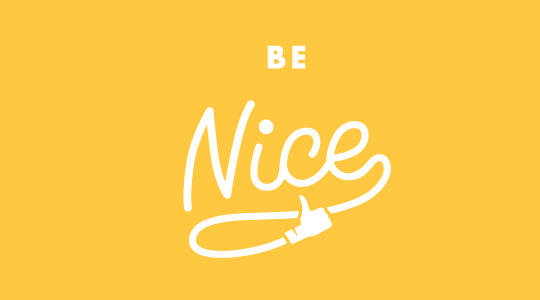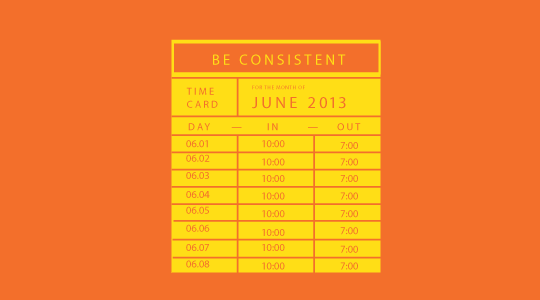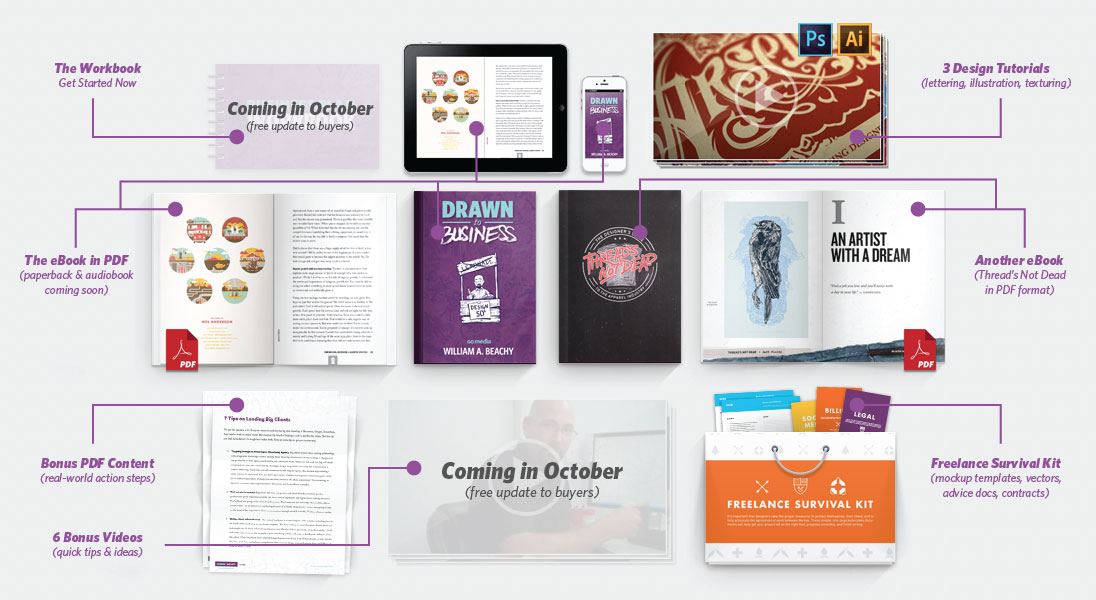Blog

How to Launch your Freelance Business: 9 Simple Tips
Doing It Alone
So, you’ve been fantasizing about taking the big leap in the freelance world. Maybe the three days at Weapons of Mass Creation Fest was just the little push over the edge you needed. Maybe the current job market looks so grim, that making it on your own seems like the best solution. Or is it that you just cannot stand living to create something you don’t believe in one minute longer?

You’re not alone. We chatted a bit with freelance designer Dan Stiles, known for his vibrant, bold and bright screen-print art prints and rock music posters honoring such acts as The Decemberists, Death Cab for Cutie, Ray Lamontagne and Sonic Youth, about his decision to dive in head first. Rena Tom, of Makeshift Society in San Francisco (a sweet co-working space and clubhouse for creative freelancers), also contributed. And lastly, we drew some gems of knowledge from both our experience here at Go Media and Bill Beachy’s book, Drawn to Business.

Deciding to go the freelance route was a no-brainer for Dan, as he cherishes his creative freedom: “My career goals don’t really fit with being an employee,” he notes. “If you look at any project I’ve done in the last 5 years you won’t find many that I could have done as an employee somewhere. I want to make the best work I possibly can. I want to make work that excites me and excites other people. In order to do that I need creative control. I can’t make exciting work as a Senior Designer at Wells Fargo, or as a Production Designer at NBC. There are too many limits. Too many cooks in the kitchen. Too many guys in pleated khakis telling me what art is. Blame it on the DIY ethic I picked up as young punk, but my goals and my attitude are best expressed on my own. Creativity is more of a shamanistic pursuit, not a team sport.”

Ready to take the leap? Be advised. Ahead of you is, according to Dan, a “complete and total lack of long term financial visibility,” continuing, “If you have a job you have a pretty good idea of how much money you will make next month, or next year. Working for yourself is a constant roller coaster ride. Additionally in order to succeed you will have to put in a Herculean amount of hours.”

Succeed and “you’re in charge of your own destiny, and you finally get to do work that is 100% yours. Not some amalgamation of what the client and the art director and the CEO’s wife like.”

How to Survive As a Freelancer
1. Complete a Business Plan
We recommend grabbing the Drawn to Business’s Business Plan Workbook or to download one you’ve found online to brainstorm, establish goals and parameters for your new business.
Do your research and be sure to ask yourself questions like:
What are the personal and professional goals for your business (1 month, 6 month, 1 year, 5 year marks)? What will success look like to you? What is your mission, vision, purpose? What is your unique value proposition? What will your brand represent to your client? What is the current demand for your services? What are other firms charging for their services?
2. Don’t Quit Your Day Job…Immediately
Sure you’re excited to jump in with both feet, but before you get in over your head, Dan recommends that you “don’t quit your day job.”
“The best way to get going is to put in your 8 hours at the office, then come home and do work you think is good for clients you like. No clients? No problem, do excellent self-directed work. Start a blog, a zine, a YouTube channel. Just make good work and lots of it. Don’t spend your evenings doing work you don’t like. Remember, you’re building your base. Don’t start out making more of the kind of work you’re hoping to escape. At some point you’ll have enough projects to quit your day job. It will be scary to cut the cord, but you’ll have to do it.”
2. Do Your Legal Research
Make sure to do your research to make sure you’re running your freelance business legally and following all laws. Consult a lawyer as needed. Here are a few things to consider:
- Establish the legal form for your business from the following: partnership, LLC, S Corporation, Corporation, Sole Proprietor.
- Research whether or not there are state or local licenses that you need to operate a freelance graphic design business.
- Look to your state’s website for their Department of Revenue or State Treasury Department regarding the need to charge sales tax for design services.
- Get an EIN (Employer Identification Number).

2. Make Yourself a Schedule.
Visualize what your days will look like. Will you dedicate a certain number of hours to your work everyday? Will you integrate work into your life more that you are on your own?
Dan recommends flexibility. “This notion that you work from 9 to 5, have a life from 6 to 11, and sleep from 12 to 7 went out the window 20 years ago for me. I am always on, but also always flexible to do what needs to get done. If I want to go snowboarding on a Monday I can do that, but if I have work to do I’ll be up until 3am getting it done. This whole notion of dividing work and home is a 18th century construct based on selling your labor to a factory during the day. Ever heard of a farmer who clocks out at 5? The farmer lives his work, so does the creative. You need to own your life and your career.”
Try this: start off on the right foot by waking up to your alarm on day one, dressing up and showing up on time for work, even if you’ve set up in your home office. Whatever it is that you decide, begin to develop a nice rhythm for yourself. We use apps like TeuxDeux, Omnifocus and Smartsheet to schedule our days and organize our projects.
3. Save, save, save
Assess your current living space and equipment. Can you get by without fancy new equipment and that hip office space?
For Dan, it does not make much sense to spend the extra money. “My life and my work are entirely intertwined. I can’t picture it any other way. I don’t stop at 5 and turn into not-working Dan. My mind is always working, even if I’m mowing the lawn. Working from home allows me to hang out with my kids at 3 in the afternoon, or make a sandwich and eat it on my front porch then go back to work until 2 am. On the bad side, I can’t really have employees or clients over, it’s just too weird. If you need space from your work, or some neutral zone for other people to be in then move out of your house. For me, I am my work, so having to drive 25 minutes to pay to sit somewhere else and do it just seems a little silly.”
In your first years as a freelancer, stick to the plan to save as outlined in your business plan. Now is not the time to break the bank.
4. Establish Your Rates
“Figure out what you need to make an hour and start there,” suggests Dan, “If you’re drowning in work raise your prices. Working out pricing is always hard. You don’t want to leave money on the table, but you don’t want to price yourself out of the job either.”
Have downtime? Keep working. Volunteer for high-profile jobs, assuring that your name is tagged on the project.

5. Be Everywhere
Get yourself out there! The more opportunity for connection with fans, followers and fellow designers the better. Once you have created your online presence, be genuine, humble and interactive. Create positive connections with your followers on Twitter, Facebook, Pinterest and the like. Not only promote yourself, but others as well. This not only builds relationships but also establishes you as an expert. When sharing what you love, be genuine.
Regarding those designers selling their wares online, Rena notes, “I think a retail presence is made up of many components these days: visual interest boards like Pinterest and Tumblr, and social media like Twitter, Facebook and Instagram, to name the biggest sites. Also, a freelancer needs to think about blogs and newsletters still, as well as maintaining their own portfolio and retail site. That’s quite a lot!
Basically, any venue where you can show your chops, or your taste, is important to your business. You don’t need all of these accounts but you should be aware of, and therefore in control of, the ones you do have. You never know which “door” someone will walk through to discover you.
I think attacking on all fronts, a little at a time, is going to be easiest to execute for some people. For others, focusing on one task only is more effective. It depends on your personal work style, and there’s no one correct answer. That said, as long as measurable progress is being made *somewhere*, that’s important. I sometimes write a weekly status update for myself. It’s not exactly a diary but you just recap all of the things you’ve done the previous week. It can be really useful to prove to yourself that you were indeed moving ahead and getting stuff done. Be authentic, be forthcoming, and show your interest(s). Participate. It’s hard to get a following if you don’t make a splash so participate and be heard!”

6. Create a Marketing Plan
Shake hands, get involved in the community, start building relationships with clients you admire through LinkedIn/Twitter, consider selling to family and friends.
“I think that’s what is hardest at the beginning – consistently marketing yourself while trying to do your work,” reports Rena, “Scheduling activities to happen on certain days, even certain hours was pretty useful in getting a lot of different activities done.”
Making time for marketing, thus, is key. Set a specific number of hours per month where you’ll be up and away from your monitor.
7. Set Up Your Metrics
Track hours logged, followers, costs, income, profit, loss. Every month review. What’s working? What isn’t? Are you hitting your goals?
8. Do Great Work and Make Sure that it is Seen
“The internet is magic,” notes Dan, “If you do good work it will sprout wings and fly off all over the interwebs. Which is why, once again, you can’t just churn out more grade B corporate design product. Make work that people want to look at and it will take you places.”
Consider starting a blog, writing tutorials and articles which will serve to not only get your work out there, but establish you as an expert. When putting your work out there, make sure it’s epic!
9. Embrace Mistakes.
“Make crappy stuff and keep working until something good comes out. It can be a stressful process, but it’s almost never a waste of time. Eventually you’ll produce something good, you will have learned a few things along the way, and you might have generated a few extra ideas that you can put in your pocket for later,” shares Dan.
 More Dan:
More Dan:
Dan Stiles | Blog
 More Rena:
More Rena:
Rena Tom | Makeshift Society | Twitter | Facebook | Pinterest | Flickr | Instagram | AngelList | LinkedIn
_____________________________________________________
Ready to Spread Your Wings?
Introducing the Freelance Survival Kit.
Not too scared yet by Dan and Rena’s cautionary tales? Are you maybe a bit unsure of where to start to tackle all of that to-do list? Well, we happen to have just the thing.
Our own Chris Comella, along with the rest of the staff, created this Freelance Survival Kit that would fit your guidance needs perfectly.
The Kit contains a series of white papers on getting your business set up legitimately, billing clients, and becoming a social media powerhouse. But that’s not it.

We’ve also included templates for contracts, project questionnaires, project agreements, and more. On top of that, we’ve also added some of our mockup templates (CD case and shirts), grunge vectors, design articles, grid kits, and Jeff’s Wacom illustration tutorial.

Being a one person shop can be hard. That’s why we crafted this product, for all of you eager to learn the tools of the trade. This is packed with years of experience. And it’s available for just under 150 bucks.
Wanna learn even more? Consider having a look at Drawn to Business, which is like the Freelancer Survival Kit on steroïds. Bill Beachy, the big chief here at Go Media took two years to write this extensive guide on how to run a design firm. It’s the result of more than 15 years in the field. And there’s plenty of additional content available too.


Still have questions? That’s what the comments are there for!
_____________________________________________
Subscribe to the GoMediaZine newsletter | Get Goodies





